Cosmos flower - what is it good for and how to grow it correctly
Cosmos or cosmos is an unpretentious, fairly common plant from the Asteraceae family. Bright white, pink and crimson flowers in the green lace of foliage look like multi-colored daisies.
Cosmea can be found everywhere in the garden, in the vegetable garden, and in the flower bed in the yard.Abundant, long-lasting flowering from June to late autumn and undemanding care and growing conditions have made these flowers popular among gardeners.
- Cosmos varieties.
- Growing cosmos from seeds.
- Planting cosmos in open ground.
- Caring for cosmos in the garden
- Diseases and pests.
- How to collect and store seeds.
- Cosmea in garden design.
Cosmos varieties
In our gardens we grow annual varieties: cosmos bipinnate and cosmos sulfur-yellow. Recently, the perennial blood-red cosmos has also become popular.
Cosmos bipinnate is an annual herbaceous plant 0.8-1.5 m high with lacy, heavily dissected leaves reminiscent of dill. The inflorescence is a basket 10-12 cm long, formed by yellow tubular flowers in the center and ligulate flowers along the edge. Flower colors are white, pink, crimson.
Today, many interesting varieties with various colors, terry, and low-growing varieties have been developed.
Below we have listed only some of the variety variety.
Cosmea shell
Cosmea shell - flowers with a diameter of 10 cm. The petals fused into a tube resemble a shell. Flower color is white, pink, red. Plant height up to 90 cm. Other varieties with the same reed flowers: Sea shell, Lady in ed.
Vega
Vega is a dwarf compact plant 30 cm high. White, red, pink flowers with a diameter of 7-10 cm.
Yakhont red
Yakhont red is a bush 60-80 cm high with red flowers with a diameter of 7 cm.
Carousel
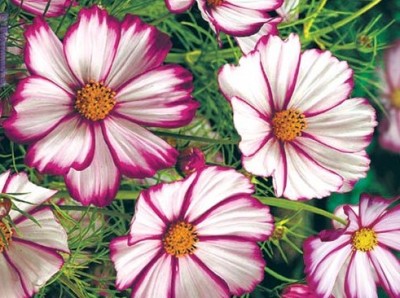
Rose Bonbon
Terry varieties: Rainbow tints, Rose bonbon, Terry button, Psyche, Snow-white marshmallow.
Cosmos sulfur yellow
Cosmos sulfur-yellow is an annual plant up to 1.0 m high with pinnately dissected foliage and inflorescences 5-7 cm from yellow to orange.
Cosmic
Cosmic is a compact plant up to 35 cm high. The flowers are double yellow, orange, bright red.
Carpet mix
Carpet mix is a plant 30 cm high with double flowers 6 cm in diameter in yellow, orange, and red shades.
Cosmea solaris
Sunny yellow, Sunny orange, Sunny red - a dwarf plant 30 cm in height. Flowers 6 cm in size are yellow, orange or red in color.
Cosmea blood red
Blood-red cosmos is a perennial heat-loving plant with velvety inflorescences of a rich dark red color, about 4 cm in size. For its subtle chocolate aroma, this flower received a second name - chocolate cosmos.
Blood-red cosmos propagates by cuttings or dividing the tuber. In autumn, the plant is transferred to a warm room for the winter. If the flower will spend the winter in the garden, you need to trim it and cover it properly.
Growing cosmos from seeds
To get earlier flowering, you can grow seedlings. In addition, some varieties are recommended to be grown as seedlings. The manufacturer usually indicates this information on the seed packaging.
When to plant seeds: Cosmos seeds should be sown for seedlings in March or early April. Take a small plastic container with holes in the bottom. Distribute the seeds over the surface of the moistened soil, press down lightly, but do not bury them. Cover the crops with film and place in a warm, bright place. Sprouts will appear in a week or two.
Seedling care. To ensure that seedlings do not stretch when growing and develop normally, the temperature should be 16-18 degrees.With thickened seedlings, seedlings that have grown to 10 cm must be pricked. To grow lush bushes, the plant can be pinched above the fifth or sixth leaf.
You can immediately sow two or three seeds in small pots, then diving will not be required.
The seedlings are planted in a permanent place at the end of May, when the threat of return frosts has passed. The distance between plants is 35-40 cm. If the planting is dense, the seedlings will stretch out and bloom less.
Planting cosmos seeds in open ground
Cosmos can be grown by sowing seeds in open ground in autumn or spring. In this case, flowering will begin in the second half of July. It is better to choose a sunny place for planting. In a shaded area, flowering will be poor. Cosmos grows well in any soil, but if planted on rich, fertilized soil, it will actively grow greenery to the detriment of flowering.
For winter planting, the beds are prepared before the onset of frost. Dig up the soil and add humus or compost. To mulch crops, you need to prepare peat or light soil with compost. Store mulch in a place protected from moisture.
In November, as soon as the soil is set by frost, seeds are distributed over the surface and lightly sprinkled with prepared dry mulch (peat, soil). The seeds will overwinter well under the snow and sprout in the spring.
Spring planting of cosmos is carried out in early May, when the soil warms up to 10 degrees. The seed material is distributed over the surface of the moistened soil and lightly patted down. There is no need to bury the seeds. Plantings can be covered with film until sprouts appear.
Cosmea tends to reproduce by self-sowing. It is enough to plant these flowers once, and every year the seeds that fell to the ground last autumn will germinate in this place.
Cosmos care
Cosmea is quite undemanding in care. All she needs is watering once a week, weeding if necessary, and loosening the soil.
If the plants look weak, you need to feed them with complex mineral fertilizer. Such feeding should be moderate. Two or three times is enough. The first feeding is carried out before budding, the second - during budding and the third - at the beginning of flowering.
You can prune heavily overgrown bushes to give a neat, compact look. A small pruning will not harm the plant; on the contrary, the flowering will be even more magnificent. Tall varieties are tied to a support.
Wilted flowers should be removed to prolong flowering and preserve the decorative appearance of the plant.
Diseases and pests
The big advantage of cosmos is its resistance to disease. It is also not afraid of pests and this greatly simplifies the care of these flowers. But if they manage your site slugs and snails, then you need to take care to protect young plants with delicate foliage.
You can lay out all kinds of traps with tasty baits and collect pests manually. Mulching the soil with sawdust, ash, crushed egg or nut shells, and coarse sand also helps a lot. Gastropods will find it difficult to crawl on such a rough surface.
How to collect and store seeds
You can collect cosmos seeds yourself. For this purpose, you need to leave the largest and brightest inflorescences. When the flowers wither, the heads with ripening seeds can be placed in gauze bags. In this case, the ripened seeds will not fall to the ground, and the birds will not be able to reach them.
Since cosmos is a cross-pollinated plant, flowers that are different from the original variety may grow from the collected seeds.
Store cosmos seeds in a dry place. Shelf life up to two to three years. During this time, the seeds remain viable.
Cosmos flowers in garden design
Many varieties of cosmos of various shades suggest wide possibilities for its use in landscape design. These flowers are perfect for decorating a site in the rustic style that is popular today, which implies simplicity and naturalness.
Cosmos can be planted not only in flower beds, but also near vegetable beds and fruit trees. With their lush flowering, they will not only please the eye, but also attract beneficial insects to destroy pests.
Tall cosmos varieties are good for creating a rear view when planted along fences or against a wall. With their lush openwork greenery with bright flowers, they decorate unsightly areas of the garden and serve as a good background for low-growing types of flowers.
You can also grow cosmos as a hedge, which can be trimmed neatly if desired.
Low-growing varieties of cosmos are grown in flower beds, flowerpots, and balcony containers. Dwarf cosmos is also suitable for planting as a border along garden paths and around flower beds.
Phlox goes well with cosmos flowers, marigold, daisies, verbena, Turkish cloves and other bright annuals.
Continuation of the topic:
- Growing snapdragons from seeds
- How to grow beautiful lobelia
- Flowers blooming in September
- Spilanthes oleracea - what to eat it with
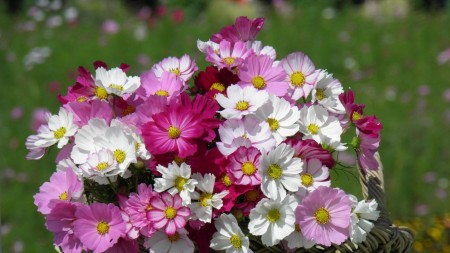
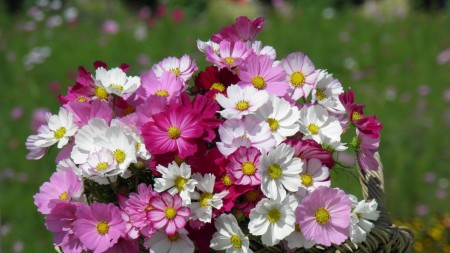
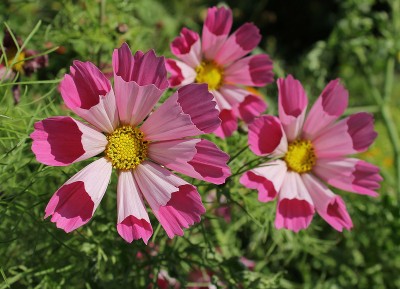

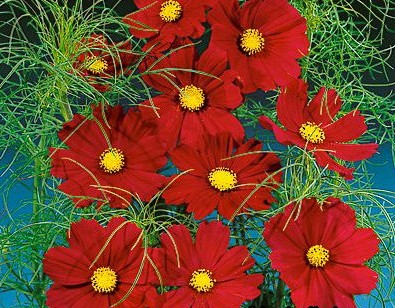
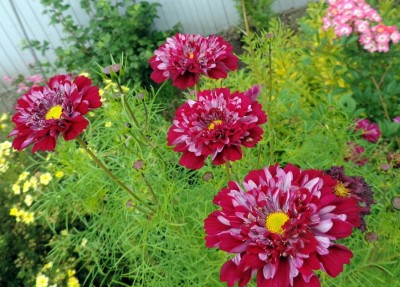
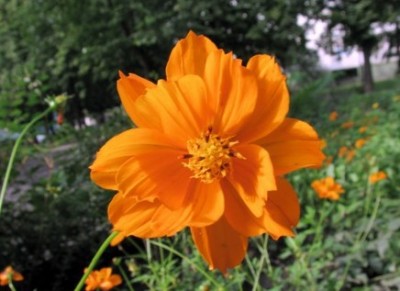
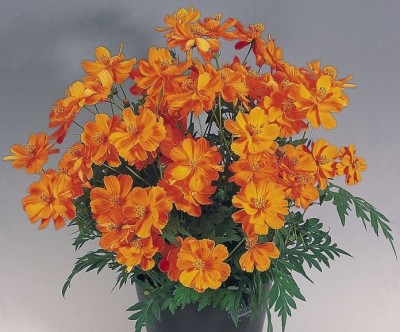
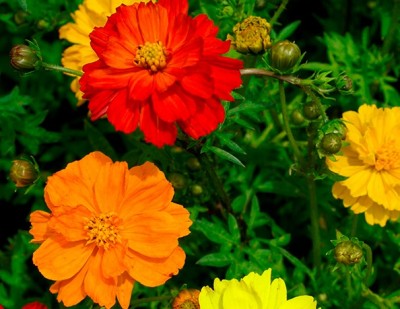
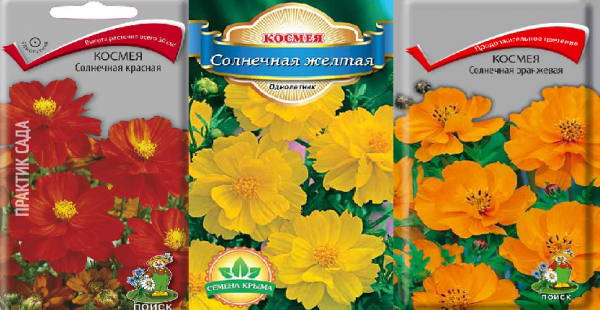
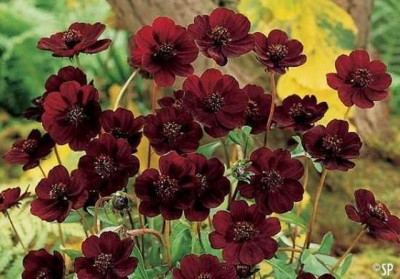
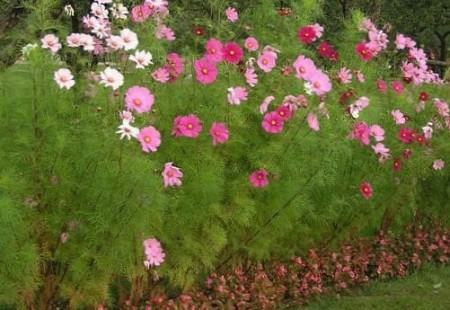


 (1 ratings, average: 4,00 out of 5)
(1 ratings, average: 4,00 out of 5) CUCUMBERS NEVER GET SICK, I'VE BEEN USING ONLY THIS FOR 40 YEARS! I SHARE A SECRET WITH YOU, CUCUMBERS ARE LIKE THE PICTURE!
CUCUMBERS NEVER GET SICK, I'VE BEEN USING ONLY THIS FOR 40 YEARS! I SHARE A SECRET WITH YOU, CUCUMBERS ARE LIKE THE PICTURE! You can dig a bucket of potatoes from each bush. Do you think these are fairy tales? Watch the video
You can dig a bucket of potatoes from each bush. Do you think these are fairy tales? Watch the video
 How our fellow gardeners work in Korea. There is a lot to learn and just fun to watch.
How our fellow gardeners work in Korea. There is a lot to learn and just fun to watch. Eye trainer. The author claims that with daily viewing, vision is restored. They don't charge money for views.
Eye trainer. The author claims that with daily viewing, vision is restored. They don't charge money for views. A 3-ingredient cake recipe in 30 minutes is better than Napoleon. Simple and very tasty.
A 3-ingredient cake recipe in 30 minutes is better than Napoleon. Simple and very tasty. Therapeutic exercises for cervical osteochondrosis. A complete set of exercises.
Therapeutic exercises for cervical osteochondrosis. A complete set of exercises. Which indoor plants match your zodiac sign?
Which indoor plants match your zodiac sign? What about them? Excursion to German dachas.
What about them? Excursion to German dachas.